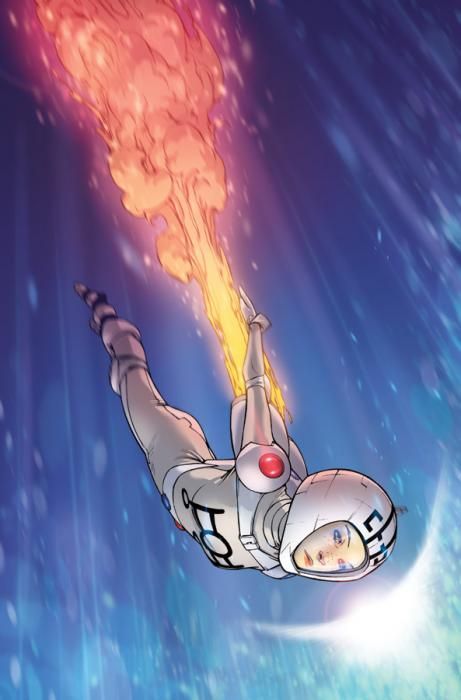Debut issues are a classic make-or-break test. The stakes are high, but there are many built-in advantages - curiosity, marketing buzz, reader excitement about new characters and a new world, not to mention collectors' interest in #1 issues -- but so often, they still fail to hook readers by falling short on the storytelling. A debut as skillful and fun as "Rocket Girl" #1 by Brandon Montclare and Amy Reeder is reason to take notice and to celebrate.
"Rocket Girl" introduces Dayoung Johansson, teenage cop in the NYTPD (New York Teen Police Department), who is on a mission to save the world, of course. Montclare begins with only a half-page of concise introduction before launching Dayoung back to the future, to the year when certain notorious "crimes against time" occurred. The alleged time criminals in 1986 are a hilarious bunch of nerdy scientists, who oddly are more on Dayoung's side than against her at this point. However, Montclare wisely leaves them just barely sketched out. For now, Dayoung's quarries in 1986 are just part of the waters in which the teen cop is a fish from the future and the star of the show.
The use of time travel in this world-saving mission may give readers jaded by too many abuses of this plot device some pause. Not to worry, the time travel hi-jinks in "Rocket Girl" #1 function mostly as a useful framing device to throw the main character in a high-stakes sink or swim position. "Rocket Girl" is science fiction, but it's about style, humor and character more than technology.
Montclare is great at giving Dayoung moments that are small windows into identity. For instance, there is earnest conviction in Dayoung's face as she tries to make her case, "Nobody is above the law, Commissioner." There are few so serious about ideals as teenagers can be. As Dayoung steps off a windowsill into the night sky, textboxes reveal her thoughts: "I get to fly. It's why I joined the NYPD." Indeed, with her jetpack and no-nonsense, take-charge attitude and nerve, Dayoung would make anyone want to be a teen cop.
Reeder's clear but amusing facial expressions combine with Montclare's sharp lines for great comedy moments, especially in the powerful opening scene in which Dayoung flashes her badge. Every creative team knows that the opening few pages of a #1 issue are critical, but it's no easy task. Montclare and Reeder don't waste a single panel or page and thus don't waste the reader's time or patience. The pacing easily rolls along without a hitch, drawing the reader in with an easily resolved (but not throwaway) series of small confrontations and trials for the heroine. "Rocket Girl" #1 doesn't take itself too seriously, and the exposition feels so effortlessly light and easy on the mind and eye that it would be easy to discount Montclare and Reeder's skill.
Even more than Montclare's script, Reeder's art gracefully builds up setting and cast without ever clumsily drawing attention to the mechanics of world-building. Her character and costume designs are pretty and also show admirable and enjoyable realism and diversity in age, ethnicity, gender and various different facial and body shapes. Her art is graceful and clean, maintaining a fluid line and backgrounds that feel spacious even with all the rich detail that makes the city feel lived-in. Reeder's camera angles are on the showy side, but this is excusable in service of the style and action. Reeder draws Dayoung moving like a gymnast or a cat, making it a pleasure to follow the rapid stream of her movements across a cityscape attractively lit up with neon signs and candy colors.
With its verve, underplayed humor and electric visuals, "Rocket Girl" #1 is one of the strongest debuts of the 2013. Here's hoping that future issues have the same light-handed execution and effervescent atmosphere.

